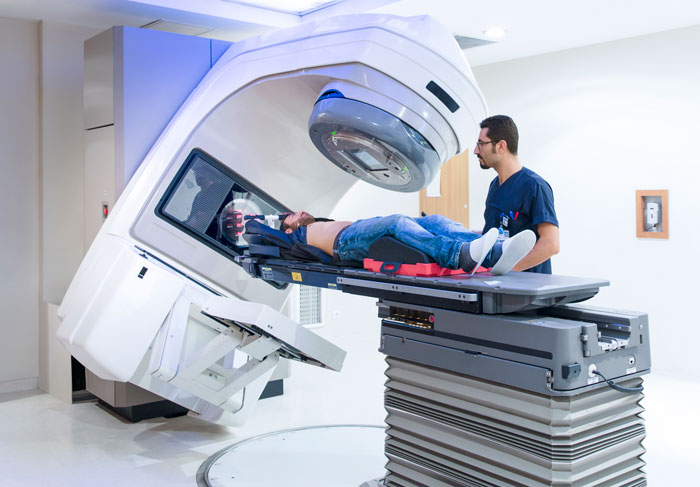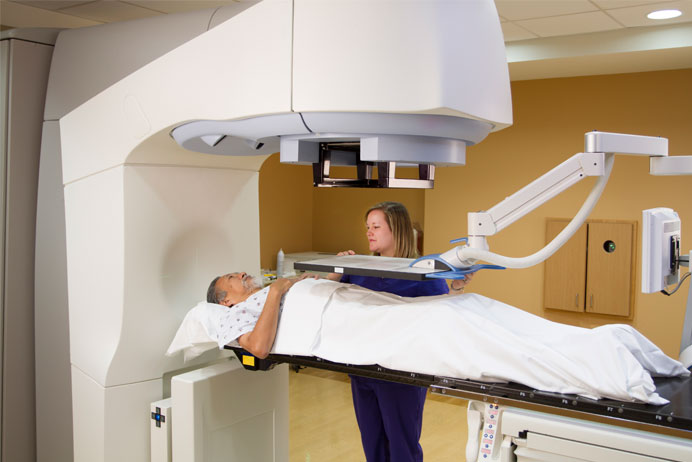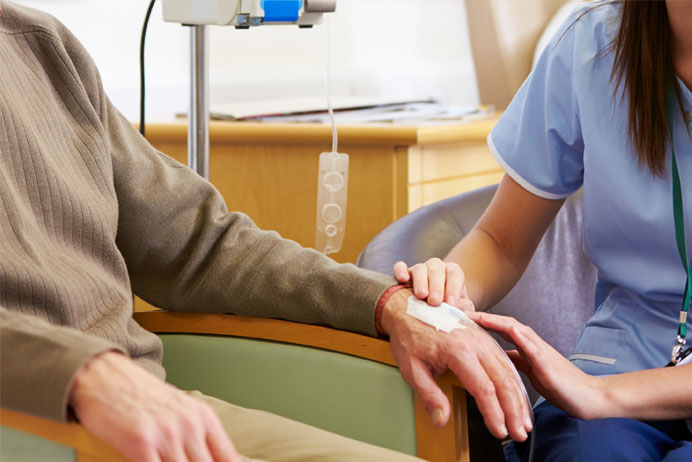Prostate Cancer Treatment
Radiation therapy is often the treatment of choice for prostate cancer.
There are several ways to treat prostate cancer. Radiation therapy, surgery or active surveillance are often viable treatment options. However, not everyone diagnosed with prostate cancer needs to start treatments immediately after receiving a diagnosis. When the time is right for treatment, it's important to review your options with a prostate cancer specialist.
The prostate cancer specialist will recommend a treatment plan based on various factors including your age, the stage of cancer, the Gleason score, and the grade of cancer. Your personal preferences will also be taken into consideration. The oncologist will describe your treatment choices, the expected results of each, and the possible side effects.
Active Surveillance:
An Approach for Men With Slow Growing Prostate Cancer

As mentioned already, the oncologist will establish the stage of cancer which is based on the size of the tumor, the grade of cancer (an indication of how slow or quickly it will grow), and whether it’s grown outside of the prostate capsule.
Tumors with higher grades are usually considered fast-growing, while tumors with lower grades are considered slow-growing. The oncologist may suggest active surveillance for patients who have been diagnosed with early stage prostate cancer that hasn’t spread to other areas of the body.
Active surveillance requires regular visits with your provider to monitor the cancer (such as every 3 to 6 months, at first). This allows the urologist to see if there are signs that the cancer is progressing.
If you and your oncologist agree that this is the best course of action, for the time being, you will have periodic tests to evaluate your PSA levels. You could also have repeat biopsies. Treatment might begin if your Gleason score rises, your PSA level starts to rise, or you develop symptoms.
Prostate Cancer Radiation Therapy
External Beam Radiation Therapy for Prostate Cancer

Intensity Modulated Radiation Therapy (IMRT)
IMRT is a type of external beam radiation therapy that uses advanced technology to manipulate beams of radiation to conform to the shape of a tumor. This makes it possible for the radiation oncologist to direct high doses of radiation to the prostate without increasing the risk of damaging nearby organs. Because IMRT can limit the side effects of treatments, many patients experience a better quality of life.

Image Guided Radiation Therapy (IGRT)
Image-Guided Radiation Therapy (IGRT) is the use of three-dimensional (3-D) imaging (CT, MRI, or PET scans), with the precise technology of IMRT to pinpoint and treat cancerous tumors. It is used before each external radiation therapy treatment session, which allows the radiation oncologist to make adjustments as needed.
Brachytherapy for Prostate Cancer Radiation Therapy
Brachytherapy, or internal radiation therapy, is the insertion of radioactive sources directly into the prostate. Sometimes this is referred to as prostate cancer seed treatment. Some men might also need to receive external beam radiation therapy in combination with brachytherapy, especially if they are at an increased risk of the cancer growing outside of the prostate.
Managing Side Effects of Radiation in the Prostate Area
As with other prostate cancer treatments, there are side effects associated with external radiation therapy. One possible side effect following prostate cancer radiation treatment is impotence. There is some chance that radiation therapy can cause sexual side effects, although they’re not always permanent.
Incontinence is another common concern. This can happen to some men, usually temporarily, after prostate cancer radiation therapy treatments. A slow urine stream might also occur for a few months after treatment. Your oncologist may be able to provide medications and exercises to help you get back to normal.
The specialists at West Florida Radiation Therapy are here to answer any questions you may have regarding side effects, including what can be done to help prevent or cope with them.

Prostate Cancer Surgery
Surgery is an option for men with early (Stage I or II) prostate cancer. It is not as commonly used for men with Stage III or IV prostate cancer. The type of surgery depends on several factors including the stage of the disease and the overall health of the patient.
If you choose to have surgery you may still need to have radiation therapy to be sure all the cancer cells have been killed. Your radiation oncologist will work with your Urologist to discuss what is recommended based on the stage and location of the cancer.
-
Robotic or laparoscopic prostatectomy. A less-invasive approach to removing the entire prostate. The laparoscopic approach involves using smaller incisions and long surgical tools to take out the prostate. In some cases, the surgeon may perform the procedure with robotic assistance.
- Radical (open) prostatectomy. The surgical removal of the entire prostate and the seminal vesicles. Lymph nodes in the pelvic area may also be removed.

Other Prostate Cancer Treatment Options

Hormone Therapy
Drugs used to block the male hormone that fuels the growth of the prostate cancer cells.

Targeted Therapy
Some patients can use drugs that target specific genes or proteins identified in an individual to slow cancer growth while protecting healthy cells.

Chemotherapy
Chemotherapy is used if the cancer has progressed to the lymph nodes or other areas of the body to kill cancer cells.
What to Expect at Your Initial Consultation with the Radiation Oncologist
At the time of consultation, the radiation oncologist will review your records, X-rays, scans and other test results and perform a physical examination. He or she may decide that additional tests are needed and will discuss that with you. This is the time when active surveillance may be discussed. If it seems as though treatments should begin now, a plan will be presented to you during the consultation, based on the results of the evaluation.
Care During Prostate Cancer Radiation Treatment
In most cases, you will be able to continue with your normal activities while undergoing radiation therapy treatment. However, your radiation oncologist may recommend that you adjust your level of activity temporarily during treatment if needed. The oncologist can talk to you about what you should do and what you should avoid regarding exercise and nutrition during this time. Nutrition information is also available through our team.
Post-Treatment Care and Ongoing Follow-up
Once you have finished a course of treatment, follow-up care instructions will be reviewed and you will return for a follow-up appointment. These may involve blood work or imaging to determine the outcome of the treatment. Our radiation oncologist works closely with urology, medical and surgical oncology, diagnostics, pathology, genetic risk evaluation, and supportive care experts, which ensures you receive the best continuous care possible.